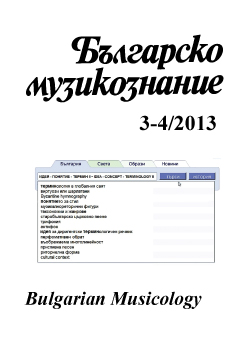За музикалната терминология на византийско-славянската общност. Начални наблюдения
Onto the Musical Terminology in the Byzantine-Slavic Community. Preliminary Observations
Author(s): Asen AtanasovSubject(s): Music
Published by: Институт за изследване на изкуствата, Българска академия на науките
Summary/Abstract: This paper offers initial observations on musical terminology used in the Byzantine-Slavic community, which has so far not been adequately studied. Byzantine music formation of musical events and their musical theoretical reflection should be seen in theological context. Any changes in the terminology of Byzantine music should not be seen as being different or consecutive stage musical and stylistic changes, but as a desire and effort to more accurately and truer rendition of music in the tradition that comes to life only on conscious relationship with God. Byzantium theoretical texts and musical terminology contained in them, systematically began to appear relatively late (14th century). The texts do not provide a complete description of the Byzantine music system. They interpret it, explaining hold without defining events and served rational systematic knowledge. Nineteenth century of the Christian East gives new but essentially old music theory. The theory is new, because it is overcome (albeit conditionally) chaotic nature of medieval texts and first given an overall vision for the music system of Byzantine music in an attempt to define and formulate the musical phenomena. But the theory remains essentially old because displays ancient musical tradition to the new (nineteenth century) time, served in a remarkable manner, the information withheld or understated in the medieval theoretical texts and considered lost forever. Little-known theoretical treatise Ηρισαντ Εἰσαγωγὴ εἰς τὸ θεωρητικὸν καὶ πρακτικὸν τής' Εκκλησιαστικῆς μουσικῆς″ (written earlier before his Great theory) is distributed primarily in handwritten form, and lately subsequently printed. The first Bulgarian musical theoretical printed text, compared to the original Greek source, shows that it is to some extent an abridged version of Chrisantos text and a number of texts are literal translations. Publication as a guide music theory for its time is relatively high. An attempt to exposure to music theory in an accessible and easy to understand and facilitate the learner through a clear translation and adaptation of the ecclesiastical terminology to the then contemporary and made initial attempts to build Slavic musical terminology, the terms are explained through simple and affordable verbal expressions. The book explains the theory and practice of church music according to the new music system. Until 1848 a book in Bulgarian gone, and its appearance is determined by the age of universal spiritual uplift and active work for the enlightenment of the Bulgarians.
Journal: Българско музикознание
- Issue Year: 2013
- Issue No: 3-4
- Page Range: 41-49
- Page Count: 9
- Language: Bulgarian
- Content File-PDF

